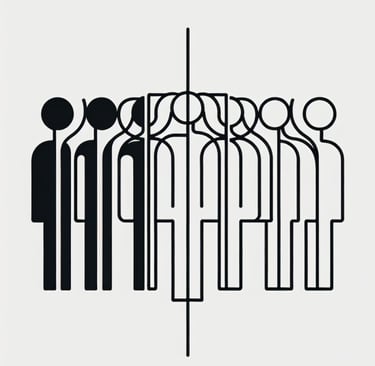Out-Group Homogeneity Bias
Out-group homogeneity bias is the tendency to perceive members of groups to which one does not belong as more similar to each other, while viewing one's own group members as diverse and unique, often leading to stereotypes and reduced empathy.
PSYCHOLOGY
7/1/20253 min read


Understanding Out-Group Homogeneity Bias
Out-group homogeneity bias describes the tendency to perceive members of an "out-group"—a social group to which one does not belong—as more similar to each other than they actually are. Conversely, individuals typically view members of their own "in-group" as diverse and unique. This cognitive bias leads to the perception that "they are all alike, but we are all different."
Causes of the Bias
This bias arises from several cognitive and social factors:
Cognitive Efficiency: The human brain naturally seeks to simplify complex information. Categorizing out-group members into a homogenous group is a mental shortcut that requires less cognitive effort than processing each individual's distinct characteristics.
Limited Contact: Individuals generally have less direct, varied, and personal interaction with out-group members compared to in-group members. This lack of diverse exposure reinforces generalized perceptions.
Selective Attention: When interacting with out-group members, individuals may unconsciously focus on behaviors or traits that confirm existing stereotypes, overlooking individual differences.
Social Identity Enhancement: Perceiving out-groups as less diverse or more uniformly negative can enhance the perceived status and distinctiveness of one's own in-group, contributing to self-esteem tied to social identity.
Manifestations in Daily Life
Out-group homogeneity bias is evident in various everyday situations:
Sports Fandom: A supporter of a particular sports team may view all fans of a rival team as uniformly exhibiting certain negative behaviors, while perceiving their own team's supporters as diverse and passionate individuals.
Generational Stereotypes: Generalizations such as "all Gen Z are lazy" or "all Baby Boomers are technologically unsavvy" illustrate how entire age cohorts, treated as out-groups, are perceived as having uniform traits despite significant internal diversity.
Professional Groups: An individual outside the legal profession might assume "all lawyers are argumentative," failing to recognize the broad spectrum of personalities, skills, and interests among legal professionals.
Political Affiliation: People on one side of the political spectrum often view all members of the opposing party as holding identical, extreme views, ignoring the wide range of opinions and nuances within any large political group.
Implications and Consequences
This cognitive bias carries significant negative implications for intergroup relations and decision-making:
Perpetuates Stereotypes and Prejudice: The bias directly contributes to the formation and perpetuation of stereotypes, leading to oversimplified and generalized assumptions about entire groups of people, which can fuel prejudice and discrimination.
Reduces Empathy: When an out-group is viewed as a monolithic entity, it becomes more difficult to empathize with individual members or understand their unique experiences and perspectives.
Increases Conflict: The "us versus them" mentality fostered by this bias can heighten tensions, misunderstanding, and hostility between different social groups.
Hindered Collaboration: In diverse teams or multicultural environments, assuming homogeneity can impede effective communication and cooperation, as individuals may make judgments based on group identity rather than individual competence.
Strategies for Mitigation
While out-group homogeneity bias is a natural cognitive tendency, it can be consciously mitigated:
Increase Intergroup Contact: Engaging in meaningful, quality interactions with individuals from different groups can challenge stereotypes and promote recognition of individual differences. This contact is most effective under conditions of equal status and shared goals.
Promote Individuation: Actively seek to recognize and appreciate the unique characteristics of individuals within out-groups, rather than focusing on their group membership.
Cultivate Awareness and Education: Understanding the existence and mechanisms of this bias can help individuals consciously challenge their own generalizations. Learning about the complexity and diversity within various social groups also helps to counter oversimplifications.
Practice Perspective-Taking: Deliberately attempting to understand situations from the viewpoint of someone from an out-group can build empathy and challenge ingrained assumptions.
Emphasize Common Identity: In organizational or community settings, highlighting overarching shared identities or goals that unite different groups can foster a broader "in-group" that encompasses previously distinct groups.
By consciously working to overcome out-group homogeneity bias, individuals can foster more inclusive environments, improve intergroup relations, and make more accurate and empathetic judgments about the diverse individuals who comprise our world.